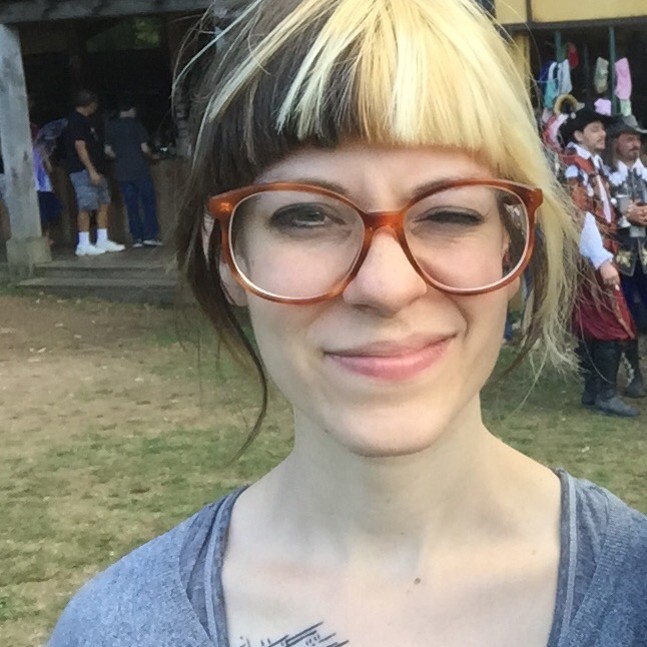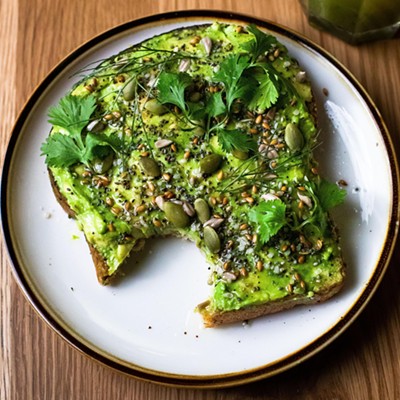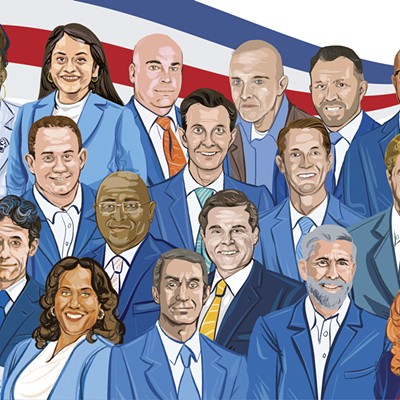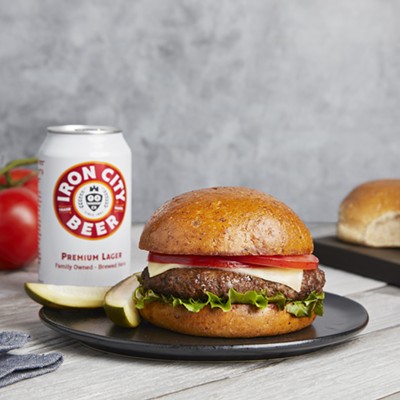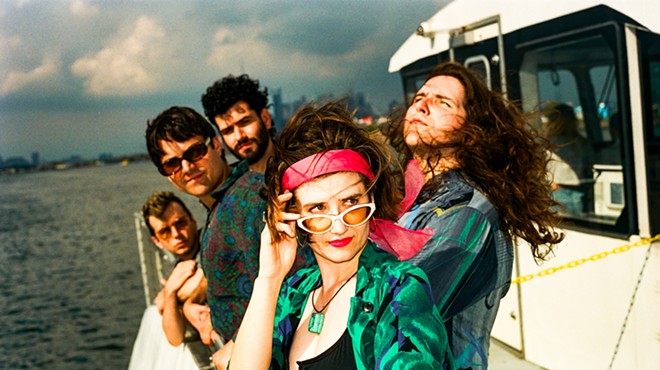Thursday, May 26, 2016
A conversation with comics journalist Em DeMarco on her first-year anniversary at Pittsburgh City Paper
We’re celebrating Em DeMarco’s first anniversary with Pittsburgh City Paper! Her story this week on The Legend of the Puke marks her first full year of contributing comics-journalism pieces for us, where she covered everything from Braddock Mayor John Fetterman’s run for Senate to the rise of sexually transmitted diseases.
Em DeMarco wasn’t always a journalist. Her first jobs out of school included seamstress, model-maker, carpenter and bread-baker. But after working for two years as an investigative-journalism fellow at Pittsburgh’s PublicSource, DeMarco decided to combine reporting with her artistic talent. That end result is what you see each month on City Paper’s “Last Page” — a totally smart approach to storytelling and a kick-ass addition to your favorite alt-weekly.
She was gracious enough to speak to us via email about her first year of contributing to CP.
Happy anniversary! What’s your favorite piece you’ve done for Pittsburgh City Paper so far?
I’m proud of the climate change story. Among other things, that was the first time I pushed past my comfort zone and began drawing the headline panel. And I think it’s an example of how I like to compare comics journalism to feeding spinach to kids. In other words, it’s a strategy of reporting big (and sometimes overwhelming) issues in a way that might be easier for some readers to digest.
Your very first comics-journalism story for us was “An Introduction to Gender Pronouns,” where you reported on the use of “they, them and their” as pronoun suggestions for transgender men and women. Since then, CP editor Charlie Deitch has implemented the use of “they” as an acceptable practice at City Paper, a decision he says was influenced by your reporting. Have you gotten any feedback from others who have been affected by your pieces?
Yes, it’s humbling to hear positive feedback from readers, people I’ve interviewed for stories and editors who I’ve worked with — including you all at the CP.
On the contrary, a reader also told us your comics journalism report “Brain-FeasterSunday,” on the Zombie Jesus Ball at the Blue Moon Bar on Easter Sunday, was “totally offensive” and “reprehensible.” Was that your first official hate mail?
Hm, I’m not sure. Probably like most reporters, I’ve had some not-so-nice things said/emailed to me by a few press officers. To be fair, I wouldn’t call that hate mail, though.
You started out working as an investigative reporter for PublicSource. Where did the interest in graphics come from?
After my two-year fellowship with PublicSource ended, I wanted to try to merge the two things I loved — reporting and drawing. I had gone to art school years earlier, but the idea of being a gallery artist made me queasy. So for years, my drawings were just things that I kept mostly to myself — kooky drawings, illustrations, comics. When I finally found my way to journalism (and was lucky enough to get the opportunity to do the PublicSource fellowship), I had already been admiring the work of other comics journalists. So I decided to give it a shot.
You have to document more than most reporters, keeping notes of both the story and the visuals. How do you keep track of everything as you’re interviewing someone: Tape the interviews, sketch while they speak, take photos?
Fannypack. And a bag with backups. The fannypack is admittedly nerdy, but I’ve found it’s the best thing for my main reporting tools (notebook, audio recorder, camera phone); the larger bag is for backups (another notebook, pens, batteries, DSLR camera and a snack, of course). Although I admire comics journalists who draw while reporting, I learned pretty quickly that I’m unable to draw and interview at the same time. I think because my brain is focused on follow-up questions in the moment, I’m unable to dedicate much attention to cartooning. But I should say that what I do is the same as any reporter. Listening, asking follow-ups, documenting the space and details, researching, fact-checking, editing, and so on. The only difference is the way the final story is told.
Are you finding it easier as you go along?
Sort of. I’ve definitely become more comfortable with the mechanics of this kind of journalism — knowing what kind of photo reference I’ll need later, how to explain my process to the people I’d like to interview, etc. But to answer your question, I often feel like I don’t know what I’m doing when I’m working on a new story. Even after having many stories behind me that I’m incredibly proud of reporting. Call it imposter syndrome or whatever you like, but what I have learned is that pattern of panic is normal for me. And what I’ve gotten better at is just pushing past all of those garbagey thoughts.
I love that you include yourself in your comics. Was that a conscious decision of yours to help document that your pieces are nonfiction?
Absolutely. Part of it is simply the economy of space. In a print story, the reporter can write one or two paragraphs to hold reader’s hands through complicated issues, or transition from one part of the story to the next. But anyone who’s done a word count will know you can blow through a couple hundred words in a snap. Especially for short pieces, like the one-pagers I do for the City Paper, I’ve got to have a story that has a beginning, middle and an end — using only about 400 words. Inserting myself in the story is a strategy to move the narrative along, make transitions, and stand in for the readers’ (and my own) confusion. (My favorite example of this is when I was reporting the story about the chickens, and the person I was interviewing used the word “vent.”)
It’s similar to writing a script for radio, which is where I got my start. With audio storytelling, you try to avoid using flowery words or long sentences. And some of my favorite moments in audio journalism happen when the producer is tapped into their own confusion. You’ll hear the producer pause or ask a short followup question. It’s in those moments, sometimes punctuated by silence, that we get to hear incredible tape from the people they are interviewing. Moments when they share heartfelt thoughts or insightful realizations.
You’ve done some work for Bitch Media, which is super rad for me to see because Bitch magazine was one of the first publications that helped me learn more about the world as a young feminist back in college. It’s very cool to picture young artists seeing such great work coming from a female with a strong voice. Has there been anything like that in your past that inspired you when you were younger?
Again, radio! During my 20s, I had been working in carpentry and other fabrication shops, listening to tons and tons of podcasts, radio journalism, audio documentaries. Studs Turkel, Amy Goodman, public radio and Indymedia. The ways they were reporting, who they were talking to, what subjects they were covering all left an enormous imprint on me.
In addition to writing and drawing, you also dabble in photography. You’re a woman of many talents! Do you get any greater satisfaction from one of those mediums?
[Blushing] Thank you! Drawing is something I’ve done for as long as I can remember. But there’s nothing that I love more than going to a show and standing stupidly close to the speakers and shooting photos. It clears my head in a way that’s hard to explain.
You recently launched The CoJo List, an email roundup of recent nonfiction comics with Washington, D.C. journalist Josh Kramer. You were our first introduction to the medium at City Paper. Have you noticed a surge in nonfiction comics journalism elsewhere?
I don’t know about a surge, but it was a welcome surprise to start receiving submissions from nonfiction cartoonists around the world. The CoJo List has been a lot of fun (and a lot of work) to put together, and I’m thankful that Josh asked me to be a part of this project. We both knew that this work existed, but compiling the newsletter has opened my eyes to just how much excellent comics journalism and nonfiction comics are being made these days. We’re hoping subscribers to the newsletter will nerd out on this stuff as much as we do.
On a lighter note, your piece this week’s issue is on Kennywood. What’s your favorite ride?
The Jack Rabbit. Apparently when I was a kid, I was so terrified,that I tried to jump out during one of the dips, my mom says. It’s not the flashiest coaster, but I love it just the same.
Where can our readers connect with you online?
My website is emdemarco.com or @eademarco on Instagram. If nonfiction comics are your thing, you can check out The CoJo List newsletter at tinyletter.com/cojo. (And if you are a nonfiction cartoonist, consider emailing us — there’s more details on The CoJo List landing page or on Twitter @cojolist.)
Em DeMarco wasn’t always a journalist. Her first jobs out of school included seamstress, model-maker, carpenter and bread-baker. But after working for two years as an investigative-journalism fellow at Pittsburgh’s PublicSource, DeMarco decided to combine reporting with her artistic talent. That end result is what you see each month on City Paper’s “Last Page” — a totally smart approach to storytelling and a kick-ass addition to your favorite alt-weekly.
She was gracious enough to speak to us via email about her first year of contributing to CP.
Happy anniversary! What’s your favorite piece you’ve done for Pittsburgh City Paper so far?
I’m proud of the climate change story. Among other things, that was the first time I pushed past my comfort zone and began drawing the headline panel. And I think it’s an example of how I like to compare comics journalism to feeding spinach to kids. In other words, it’s a strategy of reporting big (and sometimes overwhelming) issues in a way that might be easier for some readers to digest.
Your very first comics-journalism story for us was “An Introduction to Gender Pronouns,” where you reported on the use of “they, them and their” as pronoun suggestions for transgender men and women. Since then, CP editor Charlie Deitch has implemented the use of “they” as an acceptable practice at City Paper, a decision he says was influenced by your reporting. Have you gotten any feedback from others who have been affected by your pieces?
Yes, it’s humbling to hear positive feedback from readers, people I’ve interviewed for stories and editors who I’ve worked with — including you all at the CP.
On the contrary, a reader also told us your comics journalism report “Brain-FeasterSunday,” on the Zombie Jesus Ball at the Blue Moon Bar on Easter Sunday, was “totally offensive” and “reprehensible.” Was that your first official hate mail?
Hm, I’m not sure. Probably like most reporters, I’ve had some not-so-nice things said/emailed to me by a few press officers. To be fair, I wouldn’t call that hate mail, though.
You started out working as an investigative reporter for PublicSource. Where did the interest in graphics come from?
After my two-year fellowship with PublicSource ended, I wanted to try to merge the two things I loved — reporting and drawing. I had gone to art school years earlier, but the idea of being a gallery artist made me queasy. So for years, my drawings were just things that I kept mostly to myself — kooky drawings, illustrations, comics. When I finally found my way to journalism (and was lucky enough to get the opportunity to do the PublicSource fellowship), I had already been admiring the work of other comics journalists. So I decided to give it a shot.
You have to document more than most reporters, keeping notes of both the story and the visuals. How do you keep track of everything as you’re interviewing someone: Tape the interviews, sketch while they speak, take photos?
Fannypack. And a bag with backups. The fannypack is admittedly nerdy, but I’ve found it’s the best thing for my main reporting tools (notebook, audio recorder, camera phone); the larger bag is for backups (another notebook, pens, batteries, DSLR camera and a snack, of course). Although I admire comics journalists who draw while reporting, I learned pretty quickly that I’m unable to draw and interview at the same time. I think because my brain is focused on follow-up questions in the moment, I’m unable to dedicate much attention to cartooning. But I should say that what I do is the same as any reporter. Listening, asking follow-ups, documenting the space and details, researching, fact-checking, editing, and so on. The only difference is the way the final story is told.
Are you finding it easier as you go along?
Sort of. I’ve definitely become more comfortable with the mechanics of this kind of journalism — knowing what kind of photo reference I’ll need later, how to explain my process to the people I’d like to interview, etc. But to answer your question, I often feel like I don’t know what I’m doing when I’m working on a new story. Even after having many stories behind me that I’m incredibly proud of reporting. Call it imposter syndrome or whatever you like, but what I have learned is that pattern of panic is normal for me. And what I’ve gotten better at is just pushing past all of those garbagey thoughts.
I love that you include yourself in your comics. Was that a conscious decision of yours to help document that your pieces are nonfiction?
Absolutely. Part of it is simply the economy of space. In a print story, the reporter can write one or two paragraphs to hold reader’s hands through complicated issues, or transition from one part of the story to the next. But anyone who’s done a word count will know you can blow through a couple hundred words in a snap. Especially for short pieces, like the one-pagers I do for the City Paper, I’ve got to have a story that has a beginning, middle and an end — using only about 400 words. Inserting myself in the story is a strategy to move the narrative along, make transitions, and stand in for the readers’ (and my own) confusion. (My favorite example of this is when I was reporting the story about the chickens, and the person I was interviewing used the word “vent.”)
It’s similar to writing a script for radio, which is where I got my start. With audio storytelling, you try to avoid using flowery words or long sentences. And some of my favorite moments in audio journalism happen when the producer is tapped into their own confusion. You’ll hear the producer pause or ask a short followup question. It’s in those moments, sometimes punctuated by silence, that we get to hear incredible tape from the people they are interviewing. Moments when they share heartfelt thoughts or insightful realizations.
You’ve done some work for Bitch Media, which is super rad for me to see because Bitch magazine was one of the first publications that helped me learn more about the world as a young feminist back in college. It’s very cool to picture young artists seeing such great work coming from a female with a strong voice. Has there been anything like that in your past that inspired you when you were younger?
Again, radio! During my 20s, I had been working in carpentry and other fabrication shops, listening to tons and tons of podcasts, radio journalism, audio documentaries. Studs Turkel, Amy Goodman, public radio and Indymedia. The ways they were reporting, who they were talking to, what subjects they were covering all left an enormous imprint on me.
In addition to writing and drawing, you also dabble in photography. You’re a woman of many talents! Do you get any greater satisfaction from one of those mediums?
[Blushing] Thank you! Drawing is something I’ve done for as long as I can remember. But there’s nothing that I love more than going to a show and standing stupidly close to the speakers and shooting photos. It clears my head in a way that’s hard to explain.
You recently launched The CoJo List, an email roundup of recent nonfiction comics with Washington, D.C. journalist Josh Kramer. You were our first introduction to the medium at City Paper. Have you noticed a surge in nonfiction comics journalism elsewhere?
I don’t know about a surge, but it was a welcome surprise to start receiving submissions from nonfiction cartoonists around the world. The CoJo List has been a lot of fun (and a lot of work) to put together, and I’m thankful that Josh asked me to be a part of this project. We both knew that this work existed, but compiling the newsletter has opened my eyes to just how much excellent comics journalism and nonfiction comics are being made these days. We’re hoping subscribers to the newsletter will nerd out on this stuff as much as we do.
On a lighter note, your piece this week’s issue is on Kennywood. What’s your favorite ride?
The Jack Rabbit. Apparently when I was a kid, I was so terrified,that I tried to jump out during one of the dips, my mom says. It’s not the flashiest coaster, but I love it just the same.
Where can our readers connect with you online?
My website is emdemarco.com or @eademarco on Instagram. If nonfiction comics are your thing, you can check out The CoJo List newsletter at tinyletter.com/cojo. (And if you are a nonfiction cartoonist, consider emailing us — there’s more details on The CoJo List landing page or on Twitter @cojolist.)
Tags: Em Demarco , comics journalism , Pittsburgh , City Paper , Image


